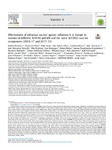Effectiveness of influenza vaccine against influenza A in Europe in seasons of different A(H1N1)pdm09 and the same A(H3N2) vaccine components (2016–17 and 2017–18)
Kissling, Esther
Pozo, Francisco
Buda, Silke
Vilcu, Ana-Maria
Rizzo, Caterina
Gherasim, Alin
Horváth, Judit Krisztina
Brytting, Mia
Domegan, Lisa
Meijer, Adam
Paradowska-Stankiewicz, Iwona
Machado, Ausenda
Višekruna Vučina, Vesna
Lazar, Mihaela
Johansen, Kari
Dürrwald, Ralf
van der Werf, Sylvie
Bella, Antonino
Larrauri, Amparo
Ferenczi, Annamária
Zakikhany, Katherina
O'Donnell, Joan
Dijkstra, Frederika
Bogusz, Joanna
Guiomar, Raquel
Kurečić Filipović, Sanja
Pitigoi, Daniela
Penttinen, Pasi
Valenciano, Marta
I-MOVE/I-MOVE+ study team
Introduction
Influenza A(H3N2) viruses predominated in Europe in 2016–17. In 2017–18 A(H3N2) and A(H1N1)pdm09 viruses co-circulated. The A(H3N2) vaccine component was the same in both seasons; while the A(H1N1)pdm09 component changed in 2017–18. In both seasons, vaccine seed A(H3N2) viruses developed adaptations/alterations during propagation in eggs, impacting antigenicity.
Methods
We used the test-negative design in a multicentre primary care case-control study in 12 European countries to measure 2016–17 and 2017–18 influenza vaccine effectiveness (VE) against laboratory-confirmed influenza A(H1N1)pdm09 and A(H3N2) overall and by age group.
Results
During the 2017–18 season, the overall VE against influenza A(H1N1)pdm09 was 59% (95% CI: 47–69). Among those aged 0–14, 15–64 and ≥65 years, VE against A(H1N1)pdm09 was 64% (95% CI: 37–79), 50% (95% CI: 28–66) and 66% (95% CI: 42–80), respectively. Overall VE against influenza A(H3N2) was 28% (95% CI: 17–38) in 2016–17 and 13% (95% CI: −15 to 34) in 2017–18. Among 0–14-year-olds VE against A(H3N2) was 28% (95%CI: −10 to 53) and 29% (95% CI: −87 to 73), among 15–64-year-olds 34% (95% CI: 18–46) and 33% (95% CI: −3 to 56) and among those aged ≥65 years 15% (95% CI: −10 to 34) and −9% (95% CI: −74 to 32) in 2016–17 and 2017–18, respectively.
Conclusions
Our study suggests the new A(H1N1)pdm09 vaccine component conferred good protection against circulating strains, while VE against A(H3N2) was <35% in 2016–17 and 2017–18. The egg propagation derived antigenic mismatch of the vaccine seed virus with circulating strains may have contributed to this low effectiveness. A(H3N2) seed viruses for vaccines in subsequent seasons may be subject to the same adaptations; in years with lower than expected VE, recommendations of preventive measures other than vaccination should be given in a timely manner.

